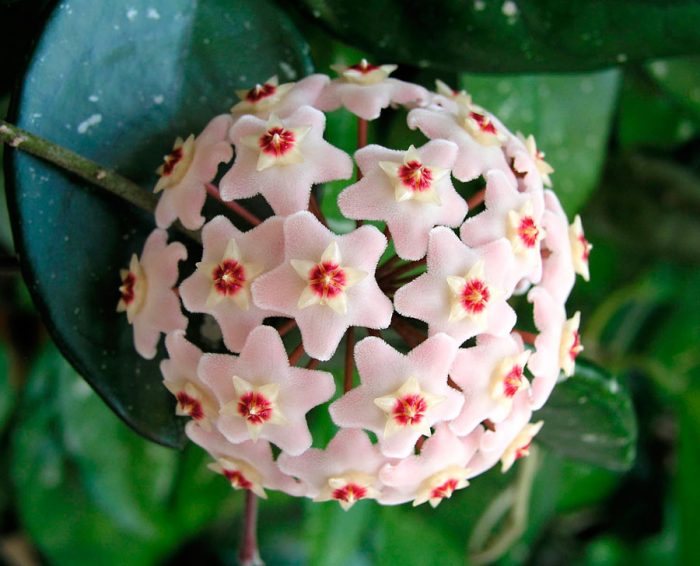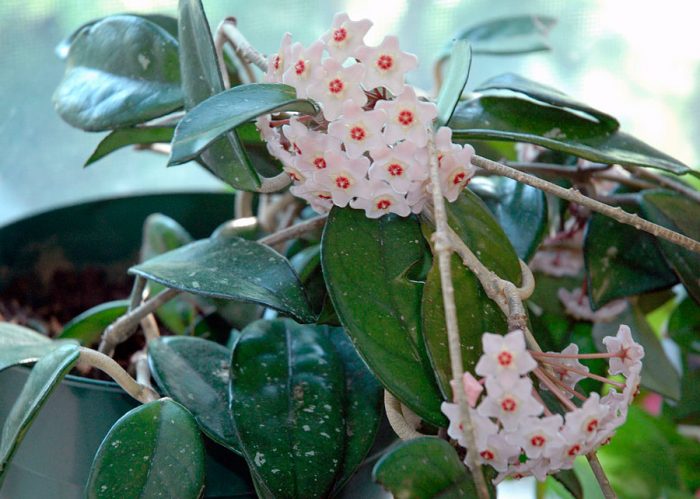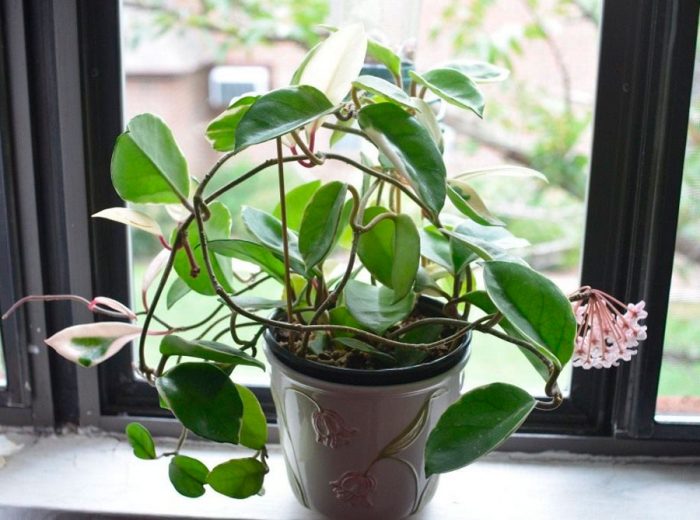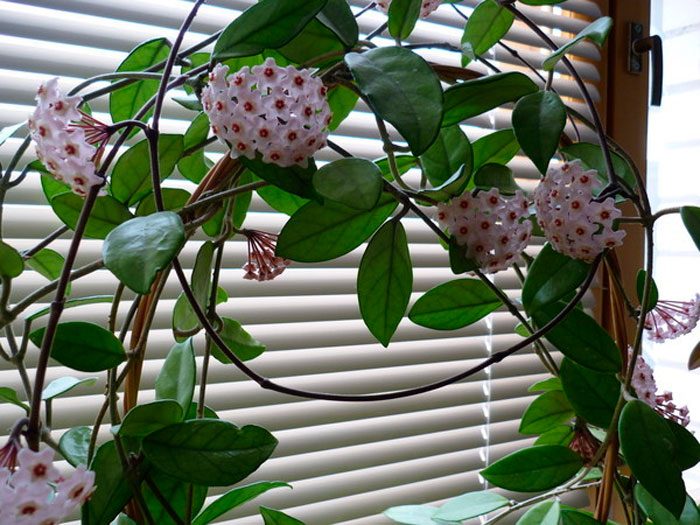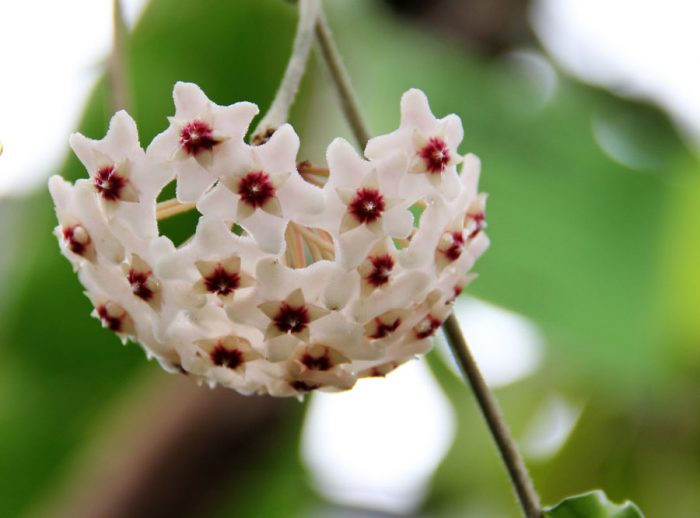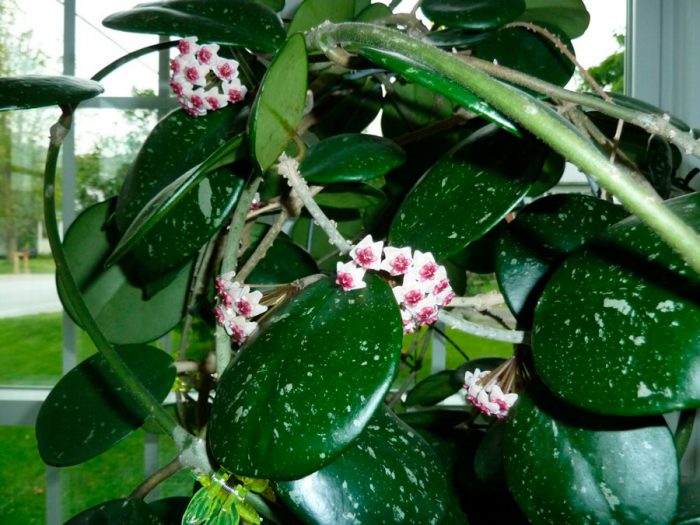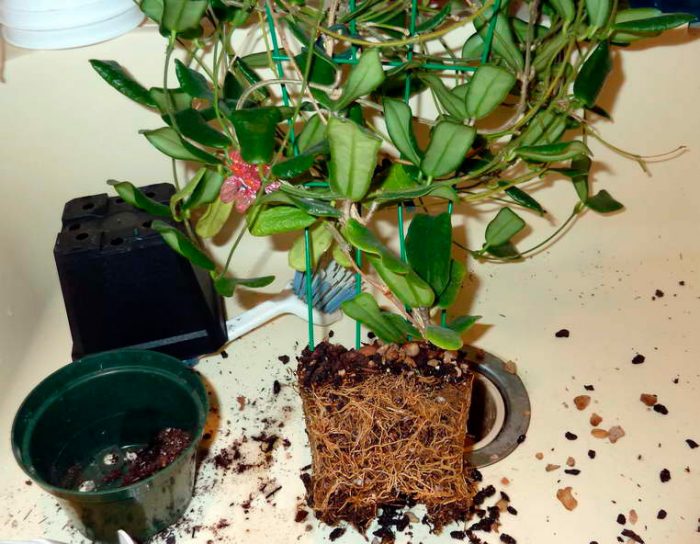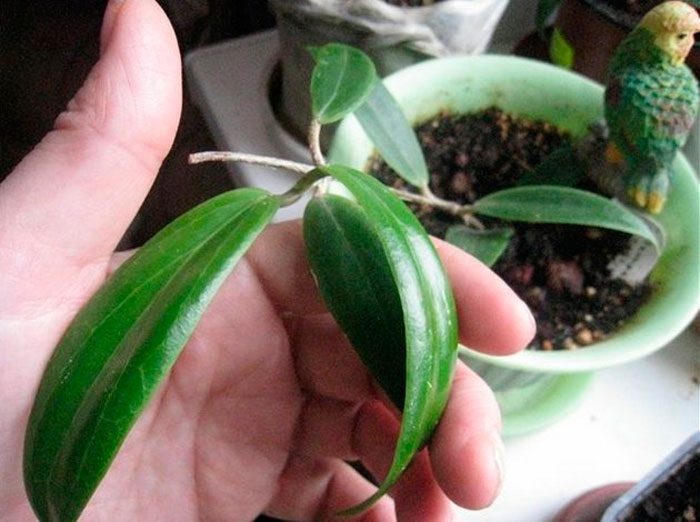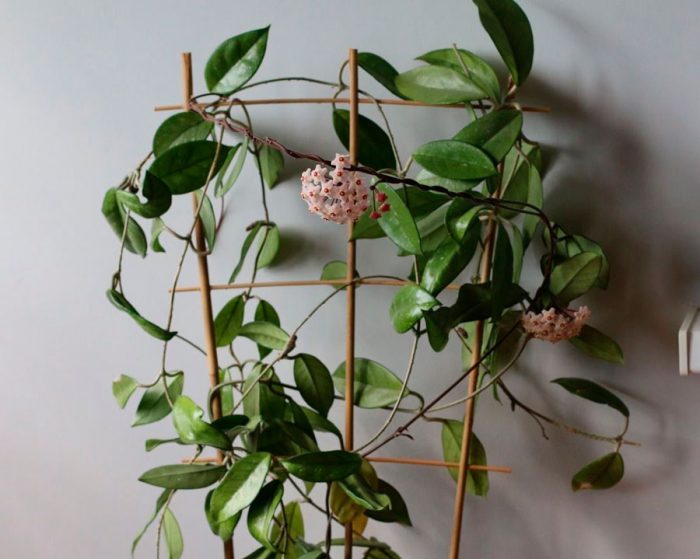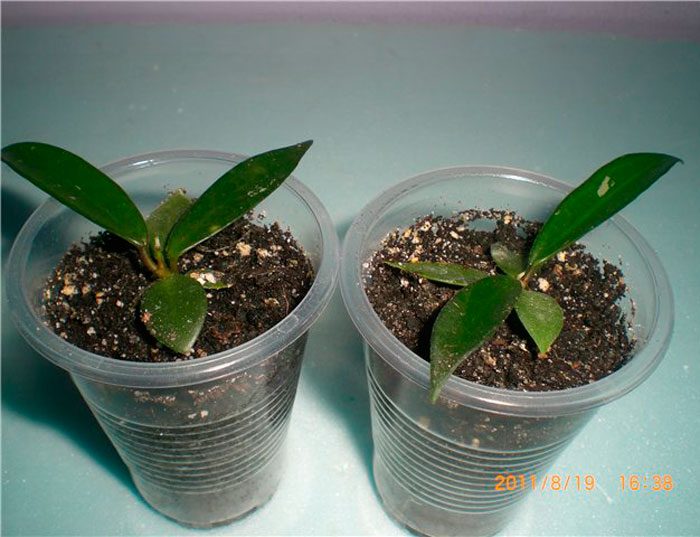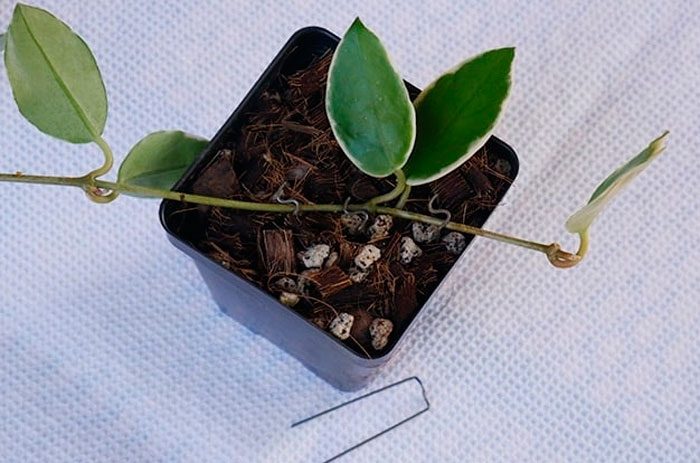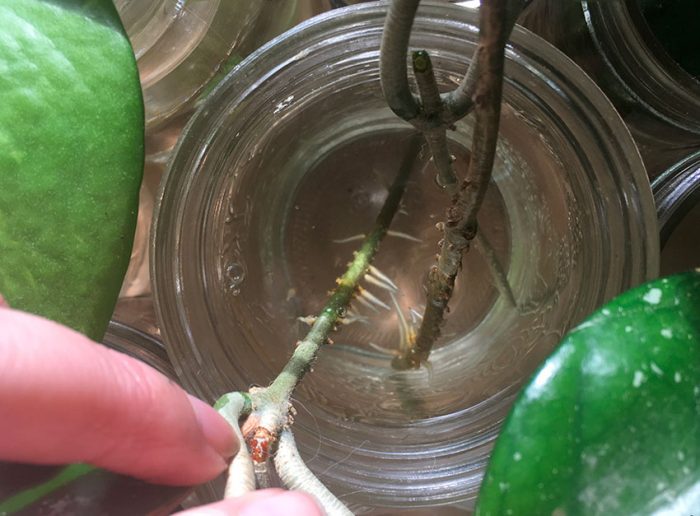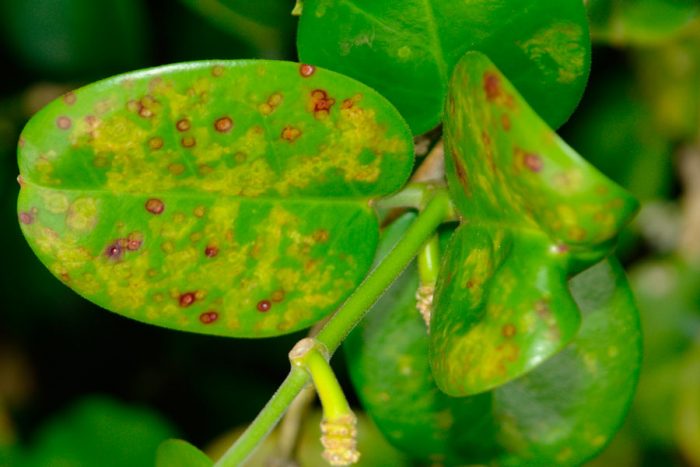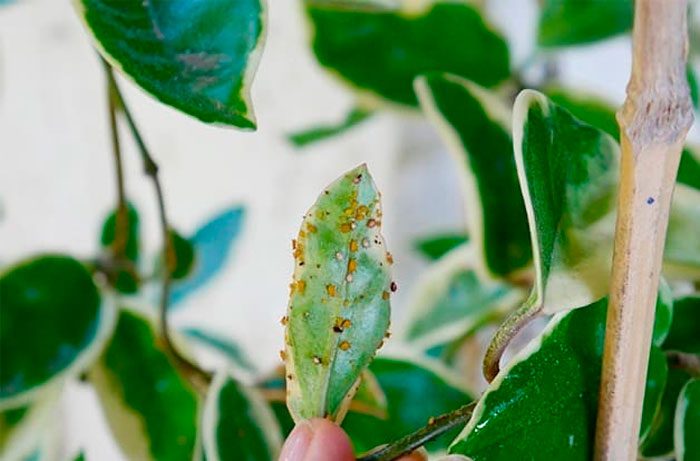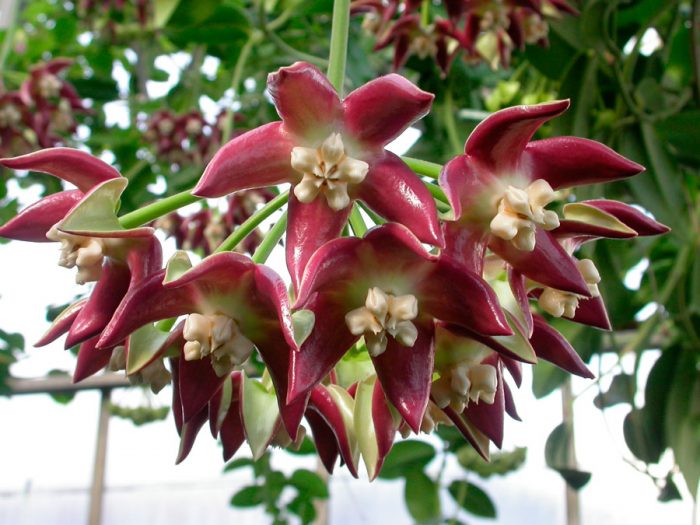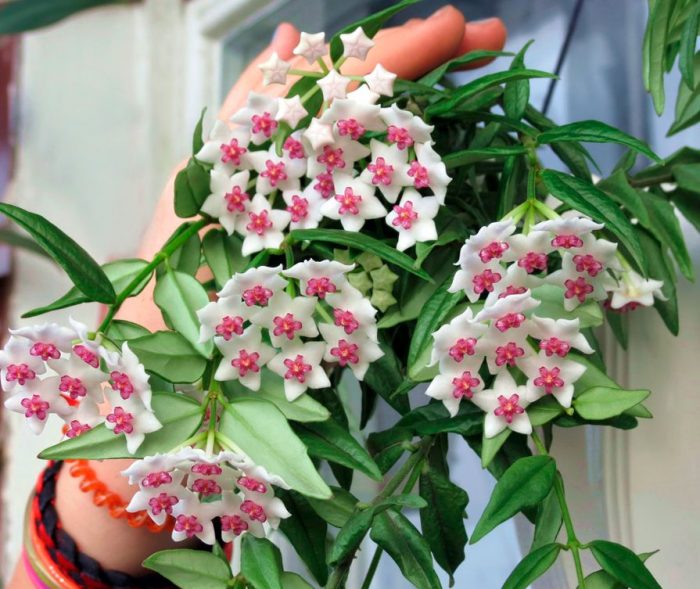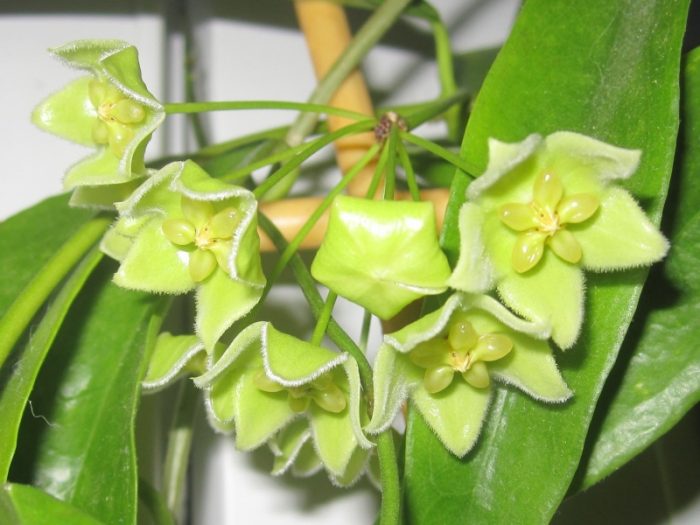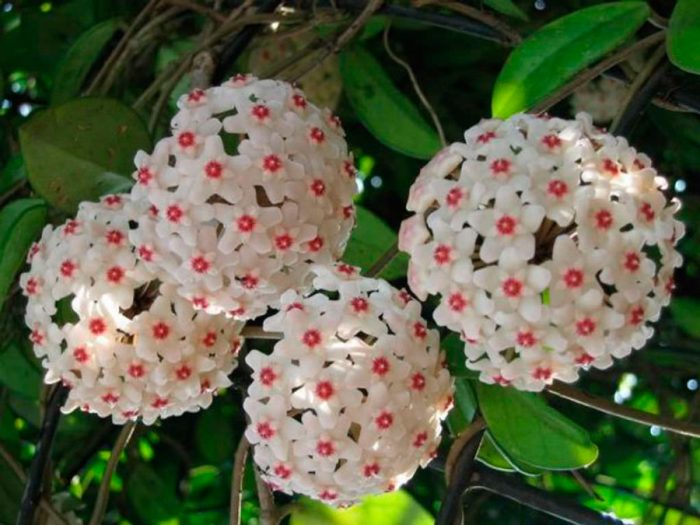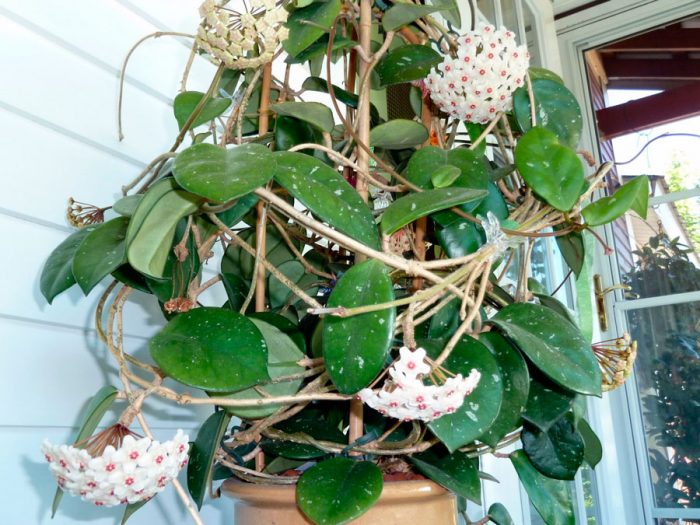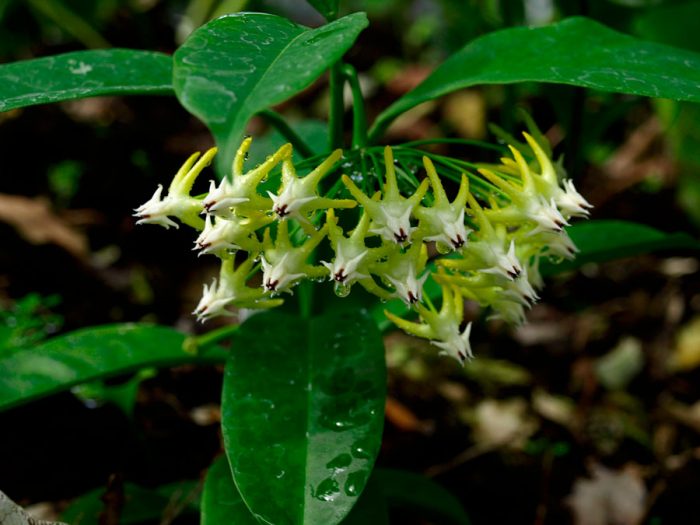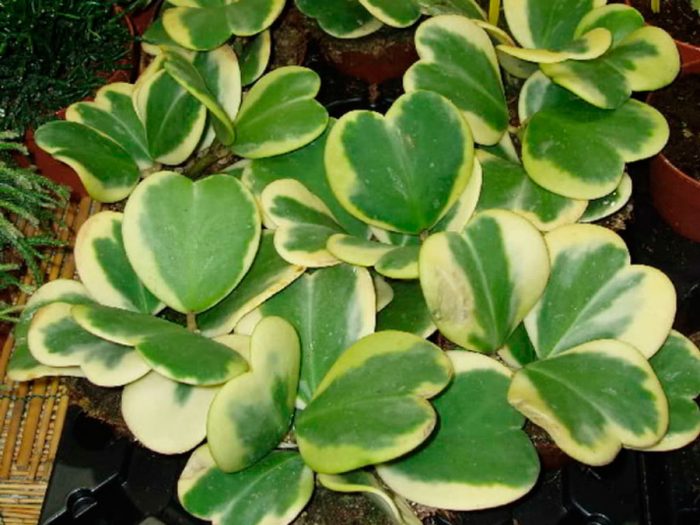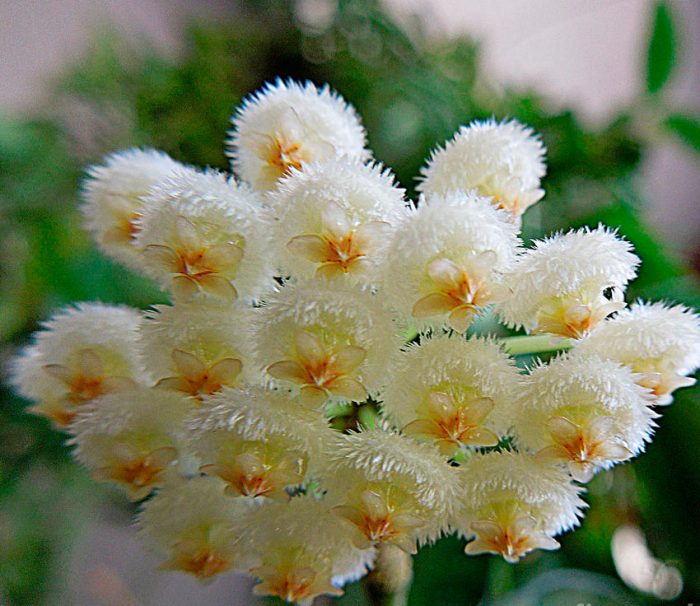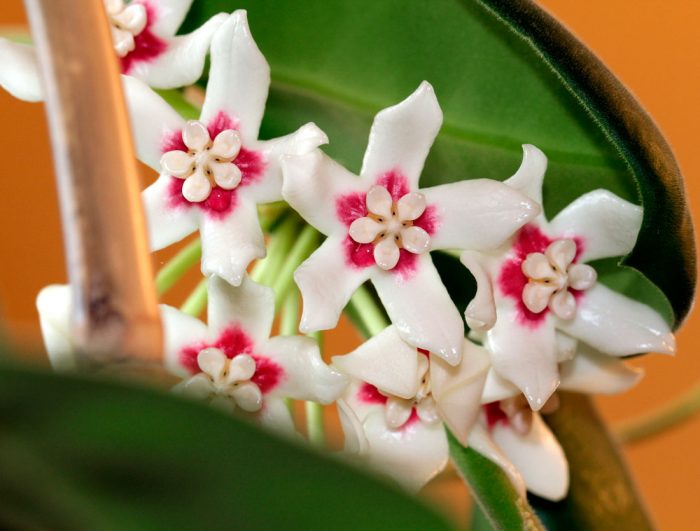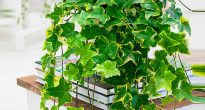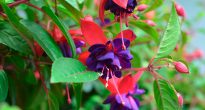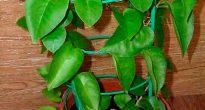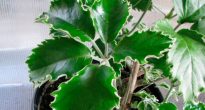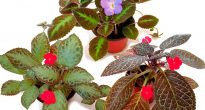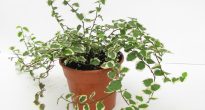Hoya is a tropical evergreen exquisite vine with a waxy coating on the foliage. If you need to plant greenery in a room, the hoya is perfect for this, and thanks to its spectacular appearance, it will not only decorate the room, but also make it more comfortable. Florists often refer to this culture as "wax ivy". It is very simple to grow it indoors, as it is distinguished by its unpretentiousness and undemanding care.
Hoye was given the name by the famous botanist R. Brown, who is the author of the theory of "Brownian motion". He described this plant in 1810 and named it after his friend T. Hoya, who was the gardener of the English Duke of Northumberland. Hoy worked in the duke's greenhouse for many years, and the main hobby in his life was the cultivation of tropical plants.
This plant is a representative of the Lastovnevye subfamily of the Kutrovye family. This genus unites more than 200 species. Hoya is most common in nature on the west coast of Australia, in the forests of Asia and in southern China. It is less common in the Canary Islands and Madagascar. In tropical areas, such a liana prefers to grow in open woodlands, creeping along rocky slopes and clinging to rarely found trees. The length of such a plant can be up to 10 m.
Content
Hoya features
Hoya is an evergreen, flowering liana. When grown in indoor conditions, its length reaches no more than 5–6 m. There are no leaves on young shoots, but they themselves are painted in a brown-violet color. Over time, young leaf plates grow on them, as well as air roots, then they change their color to green and after a certain time become lignified. Leathery leaf plates are moderately fleshy, with a wax-like coating on their surface, and there are small gray blotches on it.The size of the foliage depends on the type of hoya, as well as its color, while it can be painted in various shades of green. Young foliage is glossy, but over time it becomes matte. The shape of the leaf plates is oval, ovoid or heart-shaped. Axillary inflorescences are leathery and fleshy. Umbellate inflorescences consist of flowers, of which there can be about 50 pieces. The shape of the flowers is varied, but they all have 5 rounded petals. In diameter, the flowers reach from 10 to 20 mm, however, in the Imperial hoya species, their diameter is 80 mm. In the middle of the flower's corolla there is a five-membered crown, which rises above the petals. Outwardly, the flowers look velvety, they can be colored brown, white or pale green. Each opened flower stays in the inflorescence for about 20 days. After wilting, a new flower is formed in the place of the old one. Flowering begins in the last days of May, and the bush fades in mid-autumn. During the flowering period, the hoya produces a very large amount of nectar, which is why it is classified as a honey plant. In the midst of flowering, it is simply impossible not to smell the flowers of wax ivy.
This plant is distinguished by its absolute harmlessness. It is not a member of the poison ivy family. Other indoor flowers grow beautifully next to the hoya. Most psychics are sure that this beautiful plant has energy that helps to reduce rivalry and aggression in those people who are next to it. In this regard, they try to decorate offices with such a flower so that the working atmosphere there is more relaxed. In rare cases, the scent of the flowers can cause headaches. For people prone to allergies, experts recommend not to touch the flowers of such ivy, because this can cause dermatitis on the skin.
Hoya care at home
The most popular hoya types among florists are Meaty and Beautiful. In order for the bush to grow and develop normally, and also have a high decorative effect, it will need to create conditions that will be very close to those observed in the tropics.
Temperature regime
The plant will develop and grow within normal limits if the temperature in the room is 20-30 degrees. He needs fresh air, in this regard, it is necessary to regularly ventilate the room. If desired, in the warm season, the bush can be transferred to fresh air, but this is not necessary at all. Protect the hoya from cold drafts. The surface of the leaf plates must be systematically free from dust, and it is also necessary to regularly spray the bush from a spray bottle.
In winter, the plant is able to withstand a drop in air temperature up to 15 degrees. But if it drops to 10 degrees, then there is a high probability that the bush will die. In order for the plant to bloom every year in the summer, it should be kept cool in winter at a temperature of 16 to 18 degrees. Winter time is considered a conditional dormant period of such a plant. If the bush was hypothermic, then its foliage begins to turn yellow and fly around.
Choice of location and lighting
In the event that the hoyu is not satisfied with the place where it grows, then flowers may not appear on it. Such a plant will grow quite normally in a little shade. If you choose a window sill of western or eastern orientation for him, then the bush will delight you not only with good growth, but also with lush flowering throughout the summer and the first half of autumn. The bush will need protection from direct sunlight. For example, it can be placed against a wall in a southern room. Since this is an ampelous plant, it will be able to braid the entire wall, which will become a unique decoration of your home.However, you need to choose a place where the flower can stand for a long time, since it reacts extremely negatively to frequent rearrangements. If such a vine is often transferred from one place to another or outweighed, then because of this, not only all the buds and flowers, but also all leaf plates can fly around it. Hoya cannot be used for summer landscaping of loggias, balconies or verandas. Also, it is not recommended to put a container with a flower on a windowsill, because it reacts negatively to direct rays of the sun, and also to the proximity of heating devices in the cold season, because of this, the plant may even die.
This liana needs a fairly long daylight hours. When the weather outside the window is cloudy during the flowering period, experts recommend illuminating the vine with a phyto lamp or a fluorescent lamp, while the duration of daylight hours should be at least 12-14 hours. Wax ivy needs lighting in winter, but at this time the duration of daylight hours should be equal to 10 hours.
Even when choosing a place for such a vine, it is necessary to take into account that its flowers have a powerful smell. Therefore, it is not recommended to grow it in the room where you sleep, because you will certainly want to take it out of there, which is fraught with foliage and flowers flying around. You can not take out the vine, then the room will have to be ventilated very often. In order to avoid any special problems when growing hoya, you will need to purchase supports, which can be very different: trellises, various arcs in the shape of a heart, rings, posts, trellises or arches. They will need to tie up flexible and rather long stems of the plant, which grows on 1 bush in relatively large numbers.
If desired, a shrub can be formed from the hoya. In this case, it is necessary to carry out frequent pinching of rapidly growing stems.
Flowering features
This culture prefers the light to be bright but diffused. If the liana has enough light, then its flowering will be long, lush and spectacular. When choosing a place for wax ivy, it is imperative to take into account that during the formation of buds and flowering, it should never be rearranged, otherwise flowers and buds may partially or completely fly around from the bushes. The shoots on which the inflorescences are formed must be in a strictly vertical position, for this they must be securely supported. When the bush fades, long stems must be cut off, while those with flowers and short ones should remain. Also, peduncles should not be removed, since after a little time, buds will form again on them.
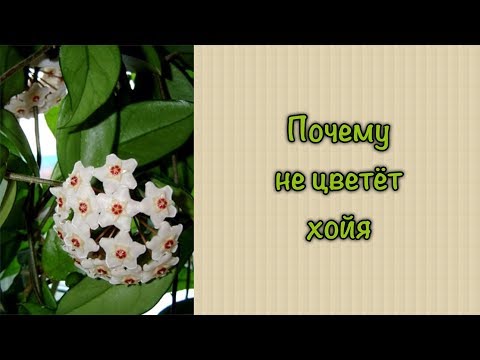

Watch this video on YouTube
How to water properly
From March to October, watering should be systematic and moderate. This procedure should be carried out approximately once every 7 days. Only soft water is suitable for this. If you use tap water, which contains chlorine, then it should settle for at least 24 hours. During this time, chlorine will have time to evaporate, and all harmful impurities should precipitate. The excess water that remains in the sump after watering must be poured out, otherwise the plant's root system may rot. In summer, watering should be carried out when the surface of the substrate dries out to a depth of 10–20 mm.
With the onset of November, watering should be reduced. In this case, the hoya should be watered two to three days after the top layer of the substrate dries out. The regularity of watering at this time is on average 1 time in 2 weeks. In autumn and winter, it is not necessary to water the hoya at all, since this will cause the root system to die off, and when spring comes, the bush will be very weak and there is a high probability that it will die.
Bathing
The flower is bathed twice a year in the spring before it blooms and in the autumn months at the end of flowering.To do this, the container with the plant must be immersed in a basin filled with water, while its temperature should be from 30 to 40 degrees. The shoots must be removed from the liquid after 7-10 minutes, while the clod of earth must remain in the water for another 30 minutes. Bathing ivy in the spring helps to bring flowering closer, and even accelerate the growth of the bush. Swimming in the autumn helps to harden the hoya, thanks to which it will gain strength and be able to survive a rather difficult winter period.
Air humidity
Such a culture is distinguished by its undemanding air humidity. It grows very well at normal room humidity. If the room has very low air humidity, then the container with the vine must be placed on a pallet filled with moistened expanded clay, and it will also be necessary to systematically humidify the air around the flower from the sprayer.
Transplant and pot
Such a vine is characterized by a fairly rapid growth. In 12 months, its length will increase by 30 centimeters, and the root system of the bush is growing at the same rapid rate. In this regard, every year in the spring, a young bush should be transplanted into a new container, while it should be 20-30 mm larger than the old one. It should be borne in mind that if the plant is not cramped in the pot, then this will have a positive effect on its development, as well as growth, while each year the stems will add 0.3-0.5 m each. However, if the hoye is a little cramped in the container , then this will positively affect the flowering, which will become more lush. Due to this feature, choosing a new pot, you can regulate the growth and flowering of the bush. If the bush is already an adult, then it does not need frequent transplants, it will be enough to carry out this procedure 1 time in 3 or 4 years. Best of all, an adult plant feels in a container that reaches from 18 to 20 centimeters in diameter.
When transplanting this vine, you need to use the transshipment method, while it is taken along with a lump of earth. A good drainage layer should be made at the bottom of the pot, which should occupy 1/3 of the volume of the container. To create it, you can take broken shards or expanded clay. If it is necessary to remove all the old substrate and replace it with a fresh one, then carefully remove the remaining soil mixture from the root system. Then the roots should be examined and all rotten and dried out areas should be cut out, treated with carbon powder. After that, the bush can be planted in a new container, which is filled with fresh soil mixture.
For such a plant it will be better if you choose a ceramic container, since its walls allow air to pass well to the root system. Regardless of which pot you choose, it must be disinfected before use. If you bought a flowering bush in the store, then its transplantation into your container will have to be postponed. We must wait until the flowering is over, and all the inflorescences will wither, only then can we start transplanting. If possible, it is better to postpone such a procedure until the onset of spring.
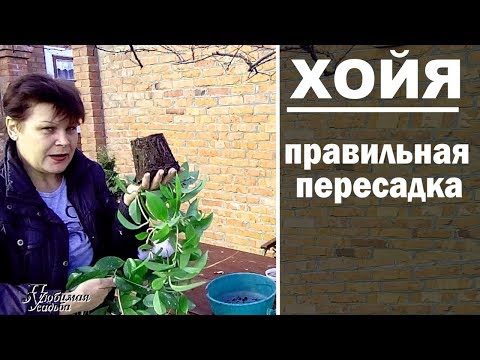

Watch this video on YouTube
Soil and fertilizing
Such a plant needs a loose substrate that allows air well, it can be neutral or slightly acidic (pH should not be higher than 6.5). As a rule, hoya does not differ in demanding soil mixture. For example, you can use a substrate that includes peat, leaf and sod land, and sand. It should be mixed with pieces of sphagnum moss, and also add a small amount of charcoal. You can also use ready-made orchid soil mixture.
During the growing season, hoya must be fed with mineral fertilizer. So, for feeding, you can use liquid complex fertilizers for orchids and other flowering succulent plants. It is enough to feed the bush only 2 times a month.The instructions should not be violated, it is better to take fertilizer a little less than the recommended amount, if the flower is overfed, this will have an extremely negative effect on the decorative effect of the plant. A newly planted or transplanted plant should not be fed for 2-3 months, but only if the bush grows in a nutritious substrate. In winter, all feeding is stopped.
Pruning
Wax ivy does not need to be pinched or trimmed frequently. After the fourth leaf plate is formed in the young bushes, the branches should be pinched for the growth of new shoots. In some cases, in order to make the plant even more beautiful, it is necessary to trim overly elongated stems from it. Cut off shoots with pruning shears. It is necessary to cut the shoot in the interval between the nodules. This procedure stimulates the flower to form new stems, and even more lush flowering. After the inflorescences dry up, the peduncles should not be removed, because after a while new flowers form on them.
Reproduction methods
Hoya can be propagated when grown indoors in several ways.
Growing from seeds
Collecting and sowing seeds is a rather laborious task. In a specialized store, it is extremely rare to meet the seeds of such a plant, while the seed from a bush grown in indoor conditions is very difficult to get, because it almost never ripens. This breeding method is most often used by breeders in large greenhouses.
When the bush has faded, seeds will form. Only those of them that are well ripe are viable, they must be dried. Seeds lose their germination very quickly, in this regard, they must be sown as soon as possible, or rather, in the year of harvest. Sowing seed is carried out in a substrate consisting of sphagnum and earth. The greenhouse must be placed in a warm and well-lit place, while ensuring that the substrate in it is always a little damp (not wet). It is also necessary to provide the crops with systematic ventilation. The first seedlings should appear about 7 days after sowing. Seedlings are characterized by very slow growth. For prophylactic purposes, in order to protect plants from fungal diseases, they must be treated with a solution of Bordeaux liquid or another agent containing copper, while the instructions attached to the preparation must be strictly adhered to. About 3 months after germination, the first leaf blades should form. After that, it will be possible to pick out young plants in individual containers. If you can collect viable seeds from your hoya and grow strong plants from them, then you are very lucky.
How to propagate by layering
This is a fairly easy breeding method, which is distinguished by its effectiveness. Such a young plant will bloom in the first year. For this type of reproduction, it is necessary to choose a specimen in which the stem can be placed in another pot, which is located next to the old one, while it must be filled with fertile soil, to which peat is added. The stalk with the knot must be fixed in the substrate with a hairpin. A small incision must be made on the stem at the rooting site, then it is covered with a sufficiently thick layer of sphagnum, then the substrate is watered a little, and the container is covered with a film on top. This pot will stand next to the parent in a well-lit and warm place until the roots and young leaf plates form on the cut. After the young sprout gets stronger, the stem should be cut, thus separating the layers from the parent plant. Then he is transplanted into an individual pot that suits him in size, and then the bush is removed to a permanent place.
There is another way to obtain a layering, for this, at the place of the incision, the stem must be wrapped with moistened sphagnum, and then with plastic wrap and tied with twine. Thus, it will be possible to create a greenhouse effect at the place of the incision, as a result of which roots are formed there. After a while, the branch is cut in order to plant it in an individual container.
Propagation by cuttings
The hoya propagation method by cuttings is the simplest of all. To do this, on last year's stem, you need to choose a site with 3 internodes and with 2-3 pairs of leaf plates. Places of cuts on the stem must be treated with garden varnish or coal powder. For rooting, cuttings can be planted in a fertile soil mixture, or you can use water for this. To increase the chances of getting a rooted cuttings, you need to cut a few pieces. In order for rooting in water to be successful, a part of an activated carbon tablet should be added to it in order to exclude infection of the cuttings with an infection, and Epin or Kornevin is also added to it to stimulate the formation of roots. The water should be well settled and lukewarm. If you wish, you can cover the container with water and the handle with a plastic bag, but do not forget to ventilate it systematically. Full rooting should take place after 15–20 days. Transplanting cuttings into individual pots can be carried out only after they get stronger and grow a little, then the container with the flower is immediately put in a permanent place. To make the bush more lush and spectacular, it is recommended to plant several cuttings in one container at once. In this case, the pot is taken a little more than usual.
If the cutting is rooted in a soil mixture, then its cut must be treated with a solution of Epin or Kornevin. The soil mixture should include perlite, earth and fine expanded clay (1: 3: 1). The cuttings are planted in the soil mixture so that the first internode is covered with a substrate. The container with cuttings must be covered with foil or glass. Then it is removed to a well-lit and warm place. In this case, it is necessary to ensure that the air temperature does not fall below 22 degrees. After 15–20 days, young leaf plates should form, this indicates that the cuttings have taken root. When choosing this method of reproduction, it must be borne in mind that in bushes grown from cuttings, the first flowering begins only in the fourth year of growth.
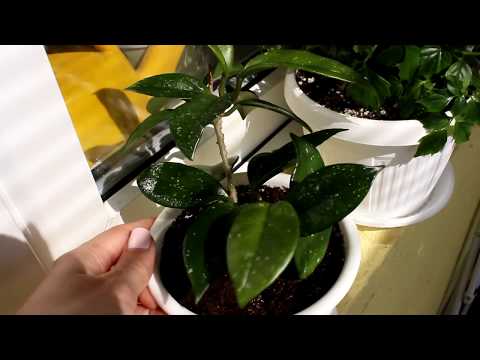

Watch this video on YouTube
Leaf propagation
Only some of the hoya species can be propagated with leaf plates. For example, the Kerry variety can be propagated by a leaf cuttings, which are planted in the soil mixture and covered with a film on top. If you want to propagate other species in this way, then the leaf may or may not take root. The roots of the leaf plate grow rather quickly, but for a long time, further growth may not be observed.
Diseases and possible problems
Too high humidity and cold can cause the development of powdery mildew and gray rot in hoya. In this case, specks of whitish or gray color are formed on the leaf plates. In order to cure powdery mildew, you need to use fungicidal preparations. If the vine is struck by gray rot, then it can die in just a few days.
Thickenings and spots that appear on the leaf plates may be a sign that the flower is infected with a viral infection. In this case, the hoya must be isolated from other flowers and observed for some time. In the event that the situation worsens, the diseased specimen must be burned, because viral diseases are considered incurable.
In the event that part of the stems and the trunk have become soft, and a sticky liquid with a not very pleasant aroma is released from them, this may mean that the hoya is affected by a bacterial infection. In this case, the flower is sprayed with a product containing copper. All diseased parts of the bush must be cut off.
Such a plant can be affected by a non-infectious disease, as a rule, this is due to a violation of the rules for caring for a flower or inappropriate conditions of detention. Below it will be described in detail the problems that arise with such a vine most often.
- Spots on foliage... They can form from the fact that the hoyu is watered with cold water, or from excess sunlight, or from overfeeding the plant with mineral fertilizers.
- Foliage dries... Leaf plates become faded, curled and dry out, either from excessive light, too cold water used for watering, or if the room is very cold.
- Slow growth... The foliage becomes faded and growth slows down due to the fact that the substrate contains insufficient nitrogen. In this case, the bush will need top dressing with a urea solution (10 g for 1 bucket of water).
- Flying around foliage... Flying around the foliage may be due to the fact that there is not enough water in the substrate or, on the contrary, there is a lot of it, it may also be due to the fact that the room is very hot, dry, and watering is excessively scarce.
- The foliage turns red... Reddening of the leaves can be due to excessively intense lighting or due to the fact that the room is very hot.
- Flying around flowers and buds... The fall of flowers and buds may be due to the fact that the bush was moved to another place during flowering, either with a lack of light, or due to regular stagnation of water in the substrate.
- Rotting roots... Stagnant water in the substrate, associated with poor drainage and overflow, can cause rot on the root system. This can lead to the death of the flower.
- Poor bloom... As a rule, hoya blooms poorly due to lack of light. If the plant does not see sunlight, then it will not bloom at all. And there are also species in which young bushes begin to bloom only 2–4 years after planting. In some cases, this is due to the fact that the bush is not sufficiently rested in winter. Cool content in winter, poor watering, 2-3 months without feeding can provoke lush flowering after returning the pot to a warm place in spring.
- Yellowing and falling of the lower leaf plates... The development of young stems deteriorates, and the lower foliage turns yellow and flies around due to hypothermia of the substrate or bush.
Pests
The root nematode can cause the greatest harm to the hoye. In the affected bush, there is a lag in growth, cessation of development, and areas of first yellow and then brown are formed on the roots, then they die off. To get rid of such a harmful insect, the bush is treated with an insecticidal preparation: Lindane, Phosphamide or Mercaptophos. The root system should be rinsed in slightly hot water (50 to 55 degrees). Excessively affected roots must be removed. The bush will need to be transplanted into a new container with a fertile substrate.
Less often, spider mites, aphids, mealybugs and other sucking pests settle on such a liana. The affected bush becomes faded, the foliage turns yellow and flies around, growth becomes slower, the buds do not open, the flowers become sticky due to the secretions of pests. In order to prevent it, it is necessary to systematically examine the bush for the presence of "intruders". It is all the more important to do this at the beginning of the spring period during the beginning of the growth of young stems. If there are very few insects, then it will be enough to rinse the bush under a warm shower. All parts must be washed. When the foliage is dry, the plant is treated with an insecticidal agent (Fitoverm, Karbofos or Aktellik). Hoya should be sprayed strictly following the instructions. Re-treatment can be carried out after 7 days.
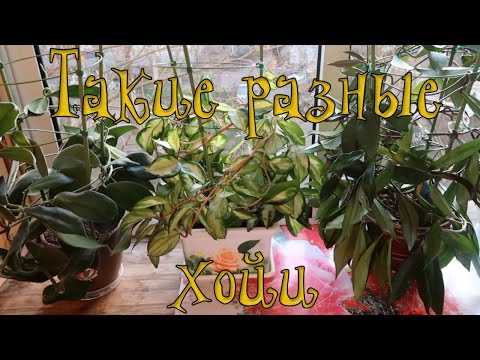

Watch this video on YouTube
Types and varieties of hoya with photos and names
Hoya is grown at home in various ways, for example:
- as ivy, twisting it around the support;
- in pots as an ampelous plant;
- like a bush with an erect stem.
For this, growers choose the desired type of such a plant.
Hoya majestic, or imperial (Hoya imperialis)
A native of this species, represented by climbing shrubs, from the Malacca Peninsula. The shape of the leaf plates is oblong-oval, their apex is slightly pointed. They are smooth, leathery and large, and reach 20 centimeters in length. Hanging umbellate inflorescences consist of 6-10 flowers, their outer surface is greenish-yellow, and the inner one is dark red. The flowers are star-shaped and have a very pleasant aroma.
Hoya Bella
This species is represented by an ampelous plant. He is originally from India. Such a plant perfectly tolerates high humidity and high temperatures when grown indoors. This not very large shrub has creeping stems covered with thickened small, sharp leaf blades at the top, the length of which is about 25 mm. Medium-sized flowers are white in color, and their crown can be painted in a unique purple-red or red. Lush bloom lasts all summer. Compared to other species, this flower has a weaker aroma; therefore, such a plant can decorate almost any room.
Hoya Chlorantha
This type is distinguished by its decorative effect. The bush is decorated with elongated leaf plates, as well as velvety flowers of brown, white or pale green color.
Hoya Fleshy (Hoya Carnosa)
This vine is very popular with flower growers. In nature, it can be found in China, Malaysia, India, Vietnam and Japan. The length of such a liana is about 6 m. When grown at home, it needs a garter, or you can install a ring support around which thin stems can twine. The color of the flowers of such a plant depends on the variety. For example, in Variegata, pale pink flowers have a white border, while Tricolor has leaves with green borders, their center is red, and over time it changes its color to yellow. Hoya Exotica has foliage with a green edging and a middle yellow color. The Crimson Queen variety has deep pink flowers with pinkish edging.
Hoya Motoskei
Such a liana reaches about 6 m in length and has creeping drooping shoots. The shape of the fleshy glossy leaf plates is heart-shaped or oblong, and their color is dark green. The foliage is about 80 mm long and up to 40 mm wide. White or pale beige flowers have a pink crown in the middle. They are part of the umbrella-shaped inflorescence and have a very pleasant smell.
Hoya Multiflora
This species comes from Malaysia. It is represented by ivy, the leaf plates of which are linear-oblong. Flowering starts very early. The flowers are long orange, they contain narrow yellow star-shaped petals with a tip in the middle. The most common varieties are with large leaf plates, but there are also small ones.
Hoya Kerri
This species is also represented by ivy. It was discovered in northern Thailand in 1911 by the American scientist A. Kerry. Subsequently, he was named after this scientist. This plant is distinguished by its high decorative effect. When grown indoors, its long shoots need a garter. Umbellate spherical inflorescences consist of 15-25 flowers, on the surface of which there is pubescence. Their color is directly related to the degree of sunlight exposure of the bush: from pale pink or lemon yellow to white with a barely discernible lemon tint. The older the bush, the darker its flowers are. In this type, the leaf plates have an unusual heart-shaped shape, which is why it is also called "Valentine" or "Hoya of Lovers".It is very simple to propagate such a species, for this it is enough to plant one leaf plate in the substrate, and after a short time it will take root.
Hoya Concave (Hoya Lacunosa)
The homeland of such a plant is Malaysia. Small greenish leaf plates with dark green edging have a diamond shape. The flowers have a delicate pleasant scent similar to perfume. This species differs from the others in its unpretentious care and high popularity among inexperienced florists.
Hoya Cup-shaped (Hoya Calycina)
This type is erect. Compared to other species, it has the longest leaf plates (about 20 centimeters).
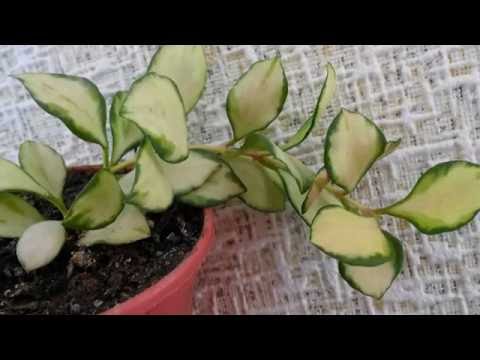

Watch this video on YouTube

